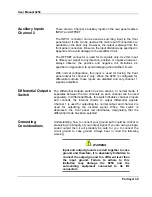
User Manual 9250
Portrayal 2-5
Preparation for Use
Preparation for use includes removing the instrument from the
container box and connecting the cables to its input and output
connectors.
Installation
If this instrument is intended to be installed in a rack, it must be
installed in a way that clears air passage to its cooling fans. For
inspection and normal bench operation, place the instrument on the
bench in such a way that will clear any obstructions to its rear fan to
ensure proper airflow.
CAUTION
Using the 9250 without proper airflow will result in dam-
age to the instrument.
Factory
Configuration of the
9250 Settings
When you order the Model 9250, you should provide details how you
want this product configured. There is some amount of flexibility in the
configuration before the instrument is shipped from the factory. The
following are factory configured settings:
Gain
The default gain setting is x10. The 9250 can be ordered with different
gain values up to x20. Bear in mind that gain x bandwidth product
remains constant and therefore, you should expect proportional
reduction in bandwidth if the gain of the amplifier is increased above
x10.
Input Impedance
The default input impedance is 50
Ω
. The 9250 can be ordered with
different input impedance values such as 75
Ω
and 1M
Ω
. The 1M
Ω
is
recommended for low frequency operation as the high input
impedance degrades the frequency response of the amplifier.
Appendix A specifies the bandwidth for the various source and input
impedances.
Source (output) Impedance
The default source (output) impedance is 50
Ω
. The 9250 can be
ordered with different load impedance values such as 75
Ω
and 600
Ω
.
The 600
Ω
is recommended for low frequency operation as the high
source impedance degrades the frequency response of the amplifier.
Appendix A specifies the bandwidth for the various input and source
impedances.
















































